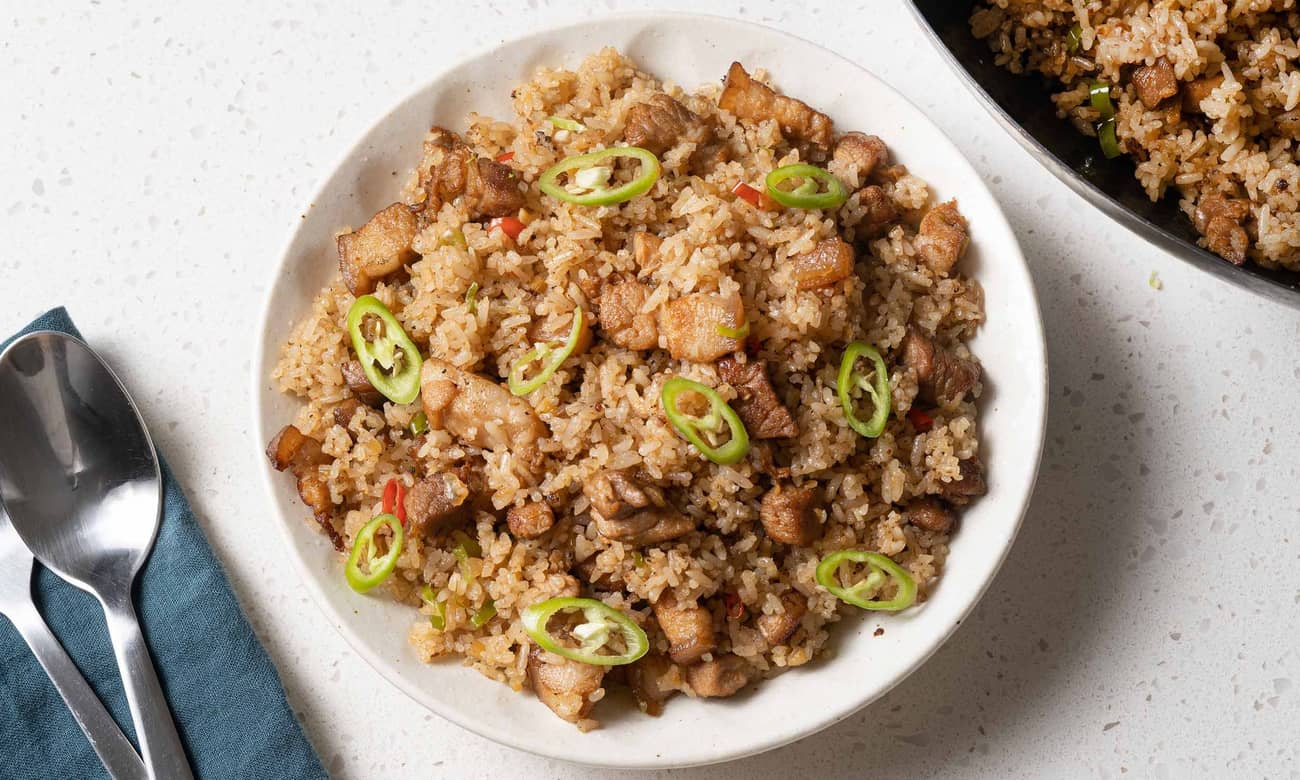
Bicol Express is a spicy Filipino stew of sliced pork belly cooked in coconut cream, shrimp paste, and tons of chilies.
Bicol Express is a spicy Filipino stew made with two signature ingredients of Bicol cuisine: fiery-hot chilies and creamy coconut milk.
Cely Kalaw, the restauranteur widely credited for inventing and popularizing the dish, named it after the old railway connecting Manila and Albay.
The origin of the dish itself is not as clear-cut. Some say that Bicol Express started as a milder offshoot of Kalaw's signature (and spicier) laing. Others claim that Kalaw adapted Bicol's gulay na lada or ginataang sili by adding pork. It could also be sinilihan, an existing Bicolano dish, repackaged with a catchier name.
Who knows? All we're sure of is you're gonna need an extra cup of rice. Even without the pork belly, the rich coconut gravy alone can serve as ulam.
Every Bicol Express needs five main ingredients:
Depending on the household, the specifics of these ingredients can change: coconut cream versus milk, green versus red chilies, bagoong guisado or alamang, ground pork versus pork belly, and so on.
This recipe gives you a solid Bicol Express to enjoy as is, or to fine-tune to your liking. Some like to use cooked pork or chicken giniling as garnish!
If you're looking for sinilihan, AKA traditional Bicol Express, we have a whole recipe for that here.
Pork belly has a good balance of fat and meat, of flavor and tenderness. Some recipes use ground pork, but we like pork belly better.
For this recipe, we slice the pork belly into small pieces that are ½- to 1-inch wide, and ½- to 1-inch thick. A bit of bone is OK.
The coconut milk is for simmering the pork and aromatics, creating the base of the sauce. The coconut cream comes in after the first reduction.
Canned or boxed coconut milk and cream will do you good. If you can get fresh coconut cream, even better! Any coconut-forward dish like this one can benefit from naturally sweet and fresh-tasting coconut.
There's probably a law in Bicol somewhere that says: Bicol Express must set your butt on fire. This recipe abides by using both siling labuyo (red chilies) and siling haba (green chilies). Make sure to save the chili seeds—that's where all the heat comes from!
The bagoong you use will affect the flavor profile of your Bicol Express:
Sear pork belly: Heat a bit of oil in a pan over medium heat. Add sliced pork belly in a single layer. Sear and cook until golden brown. Remove pork and set aside, leaving the rendered fat in the pan.
Cook aromatics & bagoong: In the same pan, sauté red onions, garlic, ginger, and red chilies in the excess fat, stirring constantly, until fragrant. Add bagoong. Continue to sauté, 1 minute. Add cooked pork belly back into the pan, stirring to coat.
Make coconut sauce: Add coconut milk and water to the pan. Stir until fully incorporated. Once mixture is boiling, reduce heat to medium-low to maintain a simmer. Cook until pork is tender and the fat begins to separate, about 40–45 minutes. The sauce should reduce to about 80%. Add coconut cream and continue to simmer for another 15–20 minutes, until pork is fully tender and sauce is thick and creamy. Garnish with green chilies and serve with hot rice.
Selina: "The thickness of the sauce is a personal preference. Some like to eat it thick and creamy. Some want to reduce the coconut cream all the way until the fat separates and reduces. There are no wrong answers."
We don't recommend using powdered coconut cream. Its flavor tends to be sweet and artificial, which works alright for sweet applications but not so much for savory dishes.
It's also difficult to get the right consistency and flavor out of powdered cream. Save yourself the trouble and go for the canned stuff. You can also make DIY cream from fresh coconut milk, if you prefer.
Of course! We highly recommend it. Fresh coconut cream and milk imparts an all-natural coconut-y sweetness to your Bicol Express—nothing too overpowering or artificial-tasting.
To make it, you need:
To make fresh coconut cream: Place grated coconut in a large bowl. Add enough warm water to moisten the coconut meat. Using both hands, squeeze meat to extract the coconut cream. Pass coconut cream through a sieve or cheesecloth to remove stray pulp. Use cream as directed.
To make fresh coconut milk: After extracting the cream, transfer the squeezed coconut pulp into a separate bowl. Pour warm water into the bowl, starting with 1 cup. Squeeze the pulp again, straining the liquid into another bowl—it should be thinner than the cream this time. If the pulp starts to feel dry, add the remaining ½ cup of warm water. Use milk as directed.
If you want it spicier, add more siling labuyo (red chilies). Make sure to add the seeds—that's where most of the spiciness comes from.
If you want it less spicy, you can either remove the seeds from the chilies, reduce the amount of siling labuyo, or both. Or you can try using just siling haba, which is less spicy than siling labuyo.
This recipe was first published in 2020. It has been updated with grocery-friendly ingredients and a new procedure in 2024.
